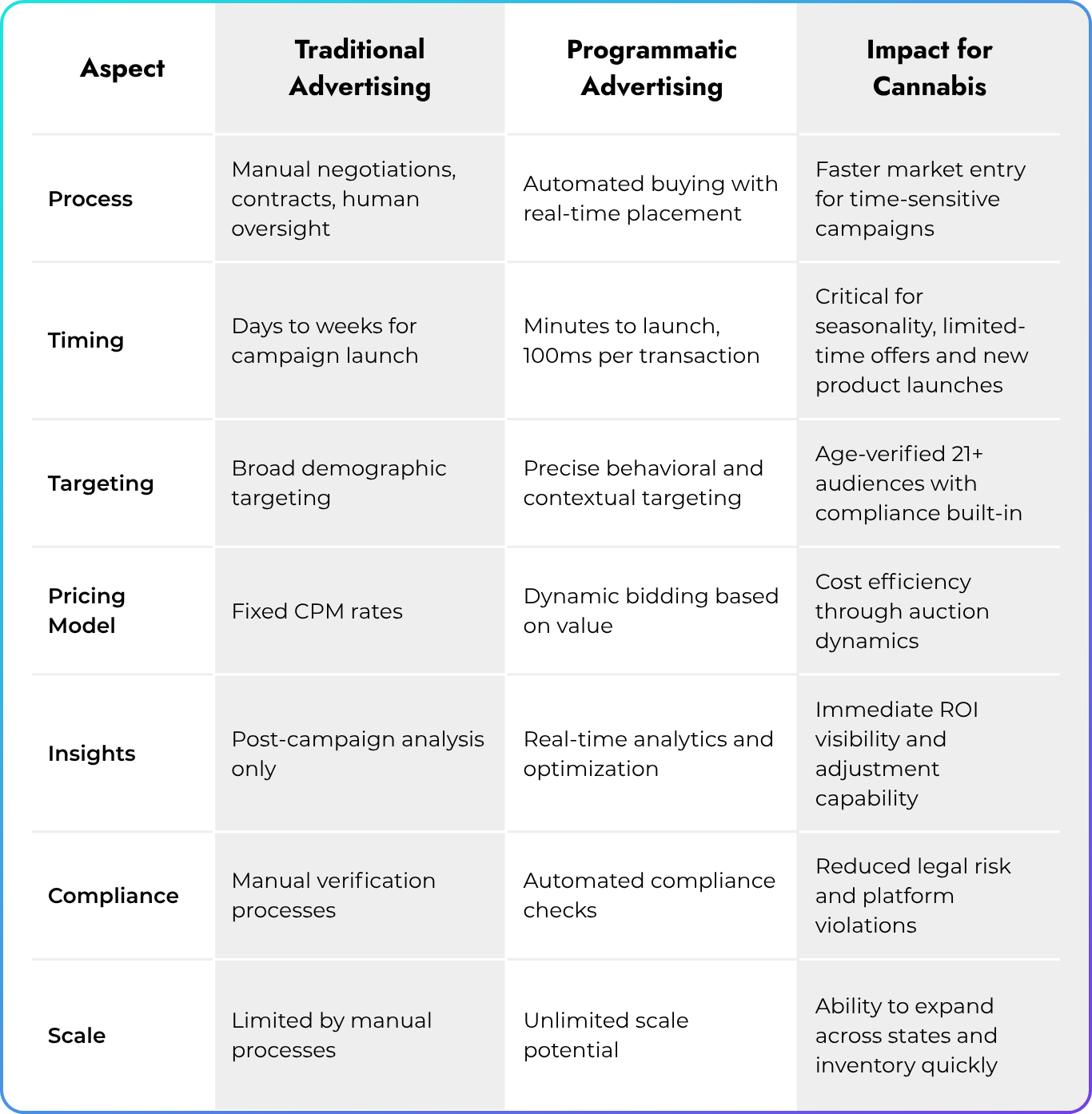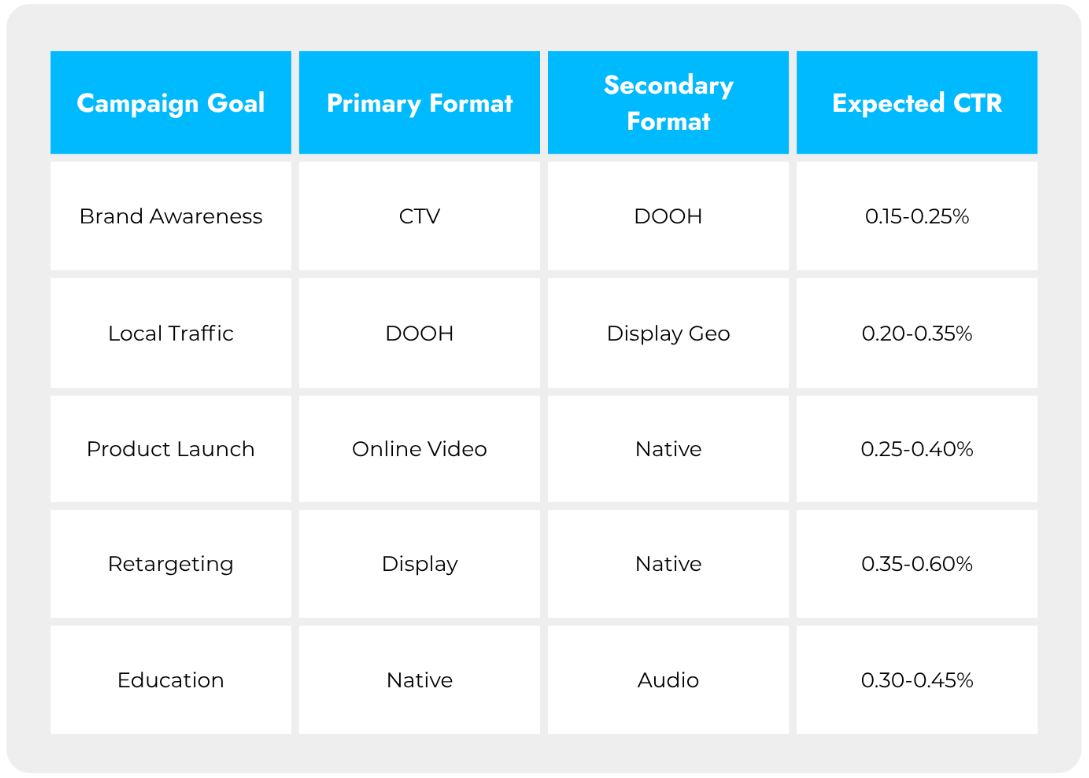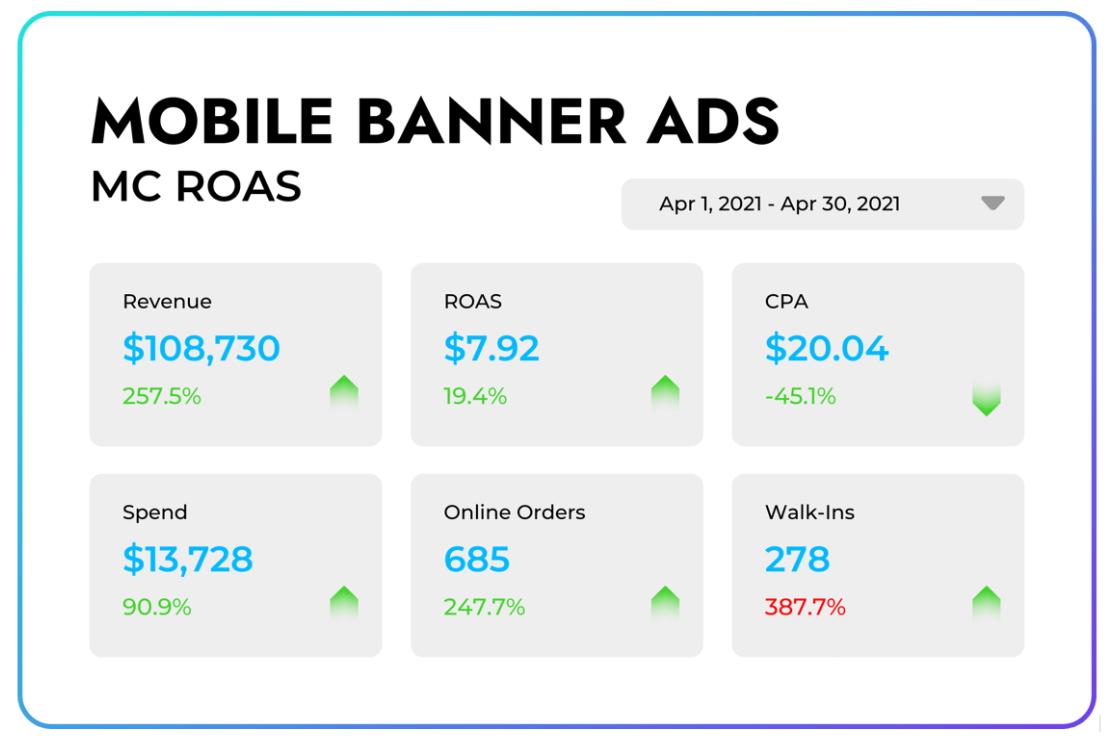Programmatic Advertising:
Understanding the Value of Programmatic

Level: Intermediate
Videos: 3
Length: 42min
What is Programmatic Advertising?
We often get caught up in the name "programmatic advertising" and think that it's something confusing and out of reach, but here's the thing—you see thousands of these types of ads every day.

Let’s say you scrolled through the ESPN app this morning, or maybe you played some Sudoku while waiting for your coffee to finish brewing. Each of the apps likely had multiple programmatic display ads (also known as banner ads) sprinkled throughout the pages as you viewed them. This is a real-world example of what programmatic advertising is: automated, data-driven ad placements delivered in real time to the right users, in the right context.

Scale Context: Now, think about how many ads you've seen on the various websites, apps, and even YouTube videos you surfed over the last week. Hundreds, if not thousands, of ads if you're a typical media consumer.
Why It Matters for Cannabis Businesses
Programmatic advertising has revolutionized the advertising marketplace by making it much quicker and easier for businesses to get their ads in front of the people who are most likely to respond to them. With the help of advanced programmatic advertising platforms, brands can automate media buying, optimize targeting in real time, and scale campaigns efficiently. And the bonus for regulated businesses is that you can serve ads on explicitly compliant mainstream websites and apps.
Industry Statistics:
- Market Share: By 2026, programmatic will account for 90% of display ad budgets worldwide
- Market Growth: Projected to reach $778 billion by 2028
- Time Savings: 29% less time on setup and management (Google study)
- Cannabis Relevance: Enables access to cannabis approved mainstream advertising channels previously unavailable
Traditional vs. Programmatic Media Buying
The Problem with Manual Media Buying
Manual media buying is the traditional process of purchasing advertising space, where advertisers or their agencies negotiate directly with publishers or media outlets to secure ad placements.
Pain Points of Traditional Advertising:
- Time-Intensive: Sifting through potential ad space, haggling over prices, and finalizing contracts can take ages
- Blind Optimization: Without real-time data, optimizing every dollar spent is like trying to hit a bullseye while blindfolded
- Limited Scalability: As your cannabis or CBD business grows, manual buying becomes increasingly complex and unmanageable
- Hidden Costs: Additional expenses from negotiations and inefficient broad targeting impact your budget
How Programmatic Buying Changed the Game
Programmatic is how we skip all of the hassle. Think of it as the ultimate shortcut in the digital advertising maze. Instead of endless back-and-forth, we let smart algorithms and a programmatic advertising platform do the heavy lifting to buy and place ads in real-time, making sure they reach the right audiences, on the right device, and on the inventory they’re most likely to engage with.
Detailed Comparison Table

How Programmatic Works: The Technical Foundation
The programmatic ecosystem is a complex network of tech and platforms that facilitate the automated buying and selling of digital ad inventory. Understanding these components helps you make informed decisions about your advertising strategy.
Key Players in the Ecosystem
1. Advertisers (You)
- Use Demand-Side Platforms (DSPs) to buy ad inventory
- Set targeting parameters and budgets
- Upload creative assets
2. Publishers (Websites/Apps)
- Use Supply-Side Platforms (SSPs) to sell ad space
- Examples: ESPN, news sites, cannabis-friendly publishers
- Control which advertisers can bid on their inventory
3. Data Management Platforms (DMPs)
- Aggregate and organize first, second and third-party audience data
- Help advertisers and DSPs build audience segments for targeting
- Enable smarter bidding, personalized messaging, and improved performance by syncing data across systems
Here's how a programmatic ad gets served in real-time:

- User visits website → Page begins loading (0ms)
- SSP sends bid request → Available impression announced (10ms)
- DSPs evaluate opportunity → Match against targeting criteria (20ms)
- Automated bidding occurs → Highest relevant bid wins (50ms)
- Ad serves to user → Creative loads on page (80ms)
- Performance tracked → Data feeds back for optimization (100ms)
Total Time: Less than 100 milliseconds (faster than a blink of an eye!)
Types of Programmatic Buying
1. Real-Time Bidding (RTB) - 90% of programmatic
- Open auction environment
- Fastest and most common method
- Best for broad reach campaigns
2. Private Marketplace (PMP)
- Invitation-only auctions
- Premium inventory access
- Higher CPMs but better quality
3. Programmatic Direct
- Fixed price, reserved inventory
- No auction process
- Best for specific publisher relationships
Core Concepts and Terminology
Real-Time Bidding (RTB) Deep Dive
Definition: Real-time bidding is an automated auction process in which programmatic ad impressions are bought and sold in real-time. Advertisers bid on individual impressions; the highest bid wins the ad placement.
How Auction Strategies Work:
1. Bid Optimization for Key Demographics
- Identify high-value audience segments (e.g., repeat cannabis customers)
- Adjust bids dynamically based on user value
- Example: Bid $9 CPM for new users, $14 CPM for past purchasers
2. Ad Placement Prioritization
- Premium placements on cannabis-friendly sites
- Higher bids for above-the-fold positions
- Strategic selection of high-engagement inventory
3. Budget Allocation Strategies
- Set daily/monthly caps by campaign type
- Allocate more to high-performing segments
- Reserve budget for retargeting (typically higher ROI)
4. Creative Optimization
- A/B test different ad variations
- Dynamic Creative Optimization (DCO) for personalization
- Adapt messaging based on user stage in the funnel
Inside the Programmatic Machine

Demand-Side Platform (DSP)
MediaJel’s DSP relationships are explicitly built for regulated industries. It offers compliant, data-driven ad buying across trusted inventory sources.
- Audience Targeting: Define segments by demographics, behavior, and compliance requirements
- Real-Time Bidding: Participate in auctions across multiple exchanges
- Campaign Management: Control budgets, scheduling, and optimization
- Creative Management: Upload and manage compliant ad creatives
Supply-Side Platform (SSP)
An SSP helps publishers in regulated industries manage and monetize their ad inventory, ensuring only compliant, high-quality ads are shown.
- Inventory Management: Organize and categorize available ad space
- Yield Optimization: Maximize revenue through floor prices and auction dynamics
- Quality Control: Ensure ads meet publisher standards and compliance
Data Management Platform (DMP)
A DMP is essential in programmatic advertising for organizing and activating audience data. It enables advertisers—especially in regulated industries like cannabis—to deliver more relevant, compliant campaigns by turning raw data into actionable insights. Here's how a DMP supports better targeting:
- Data Collection: Aggregate first, second, and third-party data
- Audience Segmentation: Create targetable user groups
- Insights Generation: Understand audience behaviors and preferences
- Privacy Compliance: Manage consent and data governance
Ad Exchange
An Ad Exchange is a digital marketplace where advertisers and publishers buy and sell ad inventory in real time, enabling efficient and data-driven transactions across multiple platforms.
The digital marketplace provides:
- Transaction Infrastructure: Real-time auction capability
- Transparency: Clear pricing and participant visibility
- Integration: Connect multiple DSPs and SSPs
- Dynamic Pricing: Market-driven inventory valuation
Programmatic Ad Formats Across Devices
Choosing the right ad format—like display banners, native ads, video, or connected TV (CTV)—is key to hitting your campaign goals. Each format supports different objectives, from building brand awareness to driving in-store visits or online sales. In programmatic advertising, success depends not just on who you target, but how you deliver the message.
Key Selection Criteria:
- Goal Alignment: Match format to campaign objective
- Audience Preferences: Consider how your audience consumes content
- User Experience: Balance engagement with non-intrusiveness
- Platform Context: Optimize for where ads will appear
- Performance Measurement: Choose formats with clear KPIs
Comprehensive Ad Type Overview
Connected TV (CTV) Advertising
- Format: Full-screen video ads on streaming platforms
- Best For: Brand awareness, product launches, storytelling
- Cannabis Benefits: High completion rates (90%), age-verified households
- Metrics: Completion rate, reach, brand lift
🚀 Explore CTV Advertising
Digital Out-of-Home (DOOH) Advertising
- Format: Digital billboards, transit screens, venue displays
- Best For: Local awareness, dispensary traffic, event targeting
- Cannabis Benefits: Trackable with QR codes, geofencing capabilities
- Metrics: Impressions, foot traffic lift, QR scans
🚀 Launch a DOOH Campaign
Audio Advertising
- Format: Ads in podcasts, streaming music, digital radio
- Best For: Engaged listening audiences, drive time targeting
- Cannabis Benefits: High attention during consumption, mood targeting
- Metrics: Listen-through rate, brand recall
Online Video Advertising
- Format: Pre-roll, mid-roll, post-roll video content
- Best For: Product demonstrations, educational content
- Cannabis Benefits: Complex messaging capabilities, high engagement
- Metrics: View rate, completion rate, engagement
🚀 Learn About Video Ads
Display Advertising
- Format: Banner ads, rich media, interactive displays
- Best For: Retargeting, promotional offers, broad reach
- Cannabis Benefits: Wide inventory availability, visual impact
- Metrics: CTR, conversions, viewability
🚀 Discover Display Advertising
Native Advertising
- Format: Sponsored content matching platform style
- Best For: Educational content, thought leadership
- Cannabis Benefits: Non-disruptive, high engagement rates
- Metrics: Engagement rate, time on site, shares
🚀Learn About Native Ads
Semantic Contextual Advertising
- Format: Ads placed based on page content analysis
- Best For: Cookie-free targeting, privacy-conscious campaigns
- Cannabis Benefits: Compliance-friendly, relevant placements
- Metrics: Relevance score, CTR, conversions
🚀 Learn About Semantic Contextual
Mobile Gaming Advertising
- Format: In-game displays, rewarded video, playable ads
- Best For: Younger demographics, high engagement
- Cannabis Benefits: Captive audience, interactive experiences
- Metrics: Engagement rate, install rate, in-app actions
Ad Format Selection Matrix

Benefits for Cannabis Businesses
The Cannabis-Specific Value Proposition
Programmatic advertising helps cannabis businesses grow faster, spend smarter, and stay compliant, period.
With ad impressions costing just pennies, you can stay top of mind without blowing your budget. You reach verified 21+ audiences across mobile, desktop, CTV, and in-store screens with a consistent message that builds brand loyalty and drives real sales.
Unlike traditional channels, programmatic empowers you to:
- Reach verified 21+ audiences with precision
- Appear on premium, cannabis-friendly sites
- Optimize in real-time for better performance
- Scale across new markets with ease
Even better, programmatic doesn’t just work on its own. It supercharges your full cannabis marketing funnel, keeping your brand top of mind through smarter prospecting and retargeting strategies backed by data. You get access to premium, cannabis-approved inventory, real-time performance data, and tools to scale into new markets as laws evolve.
Below are the 8 key benefits cannabis businesses gain from using cannabis programmatic advertising, each designed to reduce acquisition costs, maximize ROI, and keep your campaigns fully compliant.
Comprehensive Benefits Overview
1. Cross-Device Visibility
What It Means: Reach audiences across CTV, DOOH, Video, Audio, Mobile, and Desktop
Cannabis Impact: Build a consistent brand presence across all touchpoints and support the buyer journey, which boosts brand stickiness.
Example: A customer sees your CTV ad at home, then receives retargeting through programmatic display ads while shopping on mobile.
2. Compliant Inventory Access
What It Means: Access to mainstream, premium ad space explicitly approved for cannabis and CBD
Cannabis Impact: Run programmatic ad campaigns on trusted wellness sites, lifestyle apps, and digital publications
Example: Run ads on wellness sites, lifestyle apps, and news platforms
3. Precision Targeting Capabilities
What It Means: Target based on demographics, interests, and behaviors
Cannabis Impact: Reach verified 21+ audiences with relevant messaging
Example: Target "wellness enthusiasts in California who visit dispensaries"
4. Real-Time Campaign Optimization
What It Means: Adjust creative, audiences, and budgets instantly
Cannabis Impact: Respond to inventory changes, competitor moves, or compliance updates
Example: Shift budget to high-performing segments within minutes
5. Cost Efficiency Through Automation
What It Means: Reduced manual processes and optimized bidding
Cannabis Impact: Lower customer acquisition costs, higher ROAS
Example: Achieve higher ROAS through algorithmic optimization
6. Unlimited Scalability
What It Means: Expand campaigns across platforms and markets easily
Cannabis Impact: Launch in new states quickly as regulations change
Example: Scale from one state to ten with the same campaign framework
7. Transparency and Analytics
What It Means: Full visibility into performance, spend, and placements
Cannabis Impact: Prove ROI and compliance to stakeholders
Example: Real-time dashboards showing revenue attribution
8. Enhanced Personalization
What It Means: Deliver customized messages based on the user journey stage
Cannabis Impact: Different messaging for new vs. returning customers
Example: Show education content to prospects, deals to past purchasers
Real-World Success Metrics
Cannabis MSO Case Study:

The strategies and insights shared in this course are based on MediaJel’s extensive experience in cannabis marketing and programmatic advertising. Results may vary based on individual implementation, market conditions, and compliance requirements.
Videos
Welcome to our Academy video series, where learning is simple, engaging, and accessible. Each video is crafted to help you grow your skills, gain new insights, and stay inspired. No matter your background or goals, there’s something here for everyone.
Resources
Browse through our collection of helpful resources designed to support your learning. You'll find useful links, materials, and tools to explore at your own pace. These resources are here to enhance your experience and keep you moving forward.
Blogs
Services
Academy
Quiz
expand & engage retain & grow
From a dispensary launching in a local market to an established brand seeking to expand worldwide, programmatic can fuel your growth.
MediaJel is the industry’s digital marketing platform of choice for grow-focused brands and retailers like you.
Ready to accelerate?